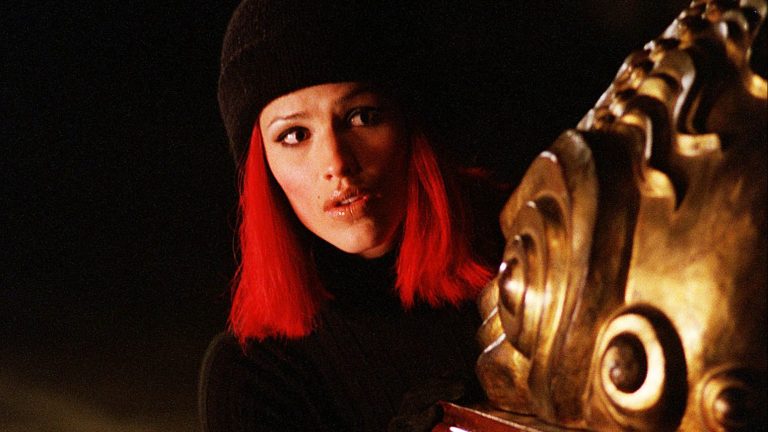How Alias Anticipated Modern Superhero Storytelling
Alias remains one of TV's best superhero shows.

J.J. Abrams’ spy drama Alias, which turns 20 this week, was a lot of things: high-octane action-adventure series, twentysomethings relationship drama, occasional National Treasure homage. It was also, surprisingly, a spiritual predecessor to today’s hyper-saturated superhero movie and TV universes: A preternaturally gifted fighter, Sydney Bristow (Jennifer Garner) inhabits comic-book-esque alter egos to infiltrate secret missions related to ancient artifacts and promised immortality, all while ensuring that her nearest and dearest don’t know how many times she’s saved the world—or which side she’s really on.
Like the series’ MacGuffin-generating Nostradamus figure Milo Rambaldi, Alias has proven to be somewhat prophetic itself about what makes for the kinds of superhero stories that land today. With some 20th-anniversary hindsight, let’s look back at what made Sydney’s story so super and what lessons Abrams’ ridiculous(ly fun) series can still impart to the current crop of superhero sagas.
The Secret Identity as Kiss of Death
The highest priority that spies and superheroes share is that they cannot get made—that is, have their identity as a larger-than-life individual linked to their “normal” selves. They must always keep their personal and professional personas separate, lest they risk losing the people who know both sides of them. Alias establishes this difficult lesson in the first half hour of the pilot, when Sydney reveals her true work (she thinks SD-6 is just a covert branch of the CIA) to doctor fiancé Danny, only for him to blab about it later and get bloodily taken out in their bathtub. It’s the first time that SD-6 treats its sweet protégée harshly, making clear the consequences of her actions should she open up to anyone else in her life. And then she defects to the CIA, which will be a death sentence for her if SD-6 ever finds out.
Yet beyond the specter of grisly assassination, what the series really digs into is Syd’s growing ethical dilemma about being a double agent where it concerns the actually good people at SD-6, primarily her longtime partner Dixon (Carl Lumbly) and sweetly awkward Q stand-in Marshall (Kevin Weisman). It would be too easy if the series were only about her getting long-game revenge on SD-6 director Arvin Sloane (Ron Rifkin); the real conflict comes from Sydney lying to Dixon’s face on every stakeout, knowing that he still thinks he’s working for the good guys and she can’t ruin that fantasy for him without potentially turning him into collateral damage.
Similarly, the moments in which Sydney’s two (or three) lives begin to collide have other heartbreaking consequences: While the scene in which her best friend Will (Bradley Cooper cast as the friendzoned buddy, amazing) gets kidnapped and sees Syd saving him, is one of the decade’s best laugh-out-loud moments, it also leads to Will going into the Witness Protection Program. His life ends, in a sense, because Sydney couldn’t keep everything compartmentalized. And we haven’t even gotten to the awful fate that befalls her best friend Francie (Merrin Dungey)…
What Alias Predicted: The beating heart (or arc reactor) of many a superhero story is this tension between selves—which means that the big reveal of a secret identity has to be carefully timed and deliberately presented. It’s as emotional as Peter Parker’s (Tobey Maguire) mask getting ripped away when he saves the subway car of people in Sam Raimi’s Spider-Man 2, as big as Spider-Man: Far From Home doxxing that Peter Parker (Tom Holland) in a commentary on fake news, or as pure and simple as Tony Stark (Robert Downey, Jr.) outing himself as Iron Man in the very first installment of the MCU. You cannot unring that bell, so it better be a memorable moment.
What Superhero Stories Can Still Learn: Rev the secret identity stakes back up! Captain America: Civil War ably took on the game-changing Marvel Comics arc of the same name by having heroes collectively unmask, and movies like Spider-Man: Far From Home are still playing out those ramifications. But mostly we see the dangerous ramifications of heroes doxxing themselves, without really digging into the strain for heroes to constantly have to lie about the things that truly matter to them.
Campy Disguises and Clever Aliases
If you’ve watched Alias or were even vaguely aware of it, no doubt the first thing you envision is Sydney in black leather and bright red hair, a.k.a. her iconic look from the pilot. Her non-SD-6-sanctioned, under-the-radar disguise (impersonating Will’s sister) displays her ingenuity and establishes the series’ brand: attention-grabbing hair paired with increasingly ridiculous outfits, from chain mail waitress ensembles to rubber dresses. She’s played punks, rich bimbos, alluring businesswomen, escorts, and all manner of female personas upon which her marks would project their assumptions—all of which belied her true strength and cunning.
Even when future episodes riffed on the color wheel with teal, magenta, purple, and good old-fashioned blonde wigs, it was still within a clear spectrum established on that pivotal mission, when she channels a silly girl who cares more about the color of her hair than her safety, only to pin her torturer with the same chair to which she’s bound.
What Alias Predicted: I would hazard a guess that Natasha Romanoff’s first appearance in 2012’s The Avengers—a seemingly helpless redhead tied to a chair, about to be nastily interrogated—was a nod toward Sydney’s triumphant pilot mission. What’s more, despite the first ten years of the MCU leaning toward sleek costumes, later phases (like WandaVision‘s cheeky Halloween callbacks) have realized that they can embrace the bold colors and campy designs of the comic-book source material.
What Superhero Stories Can Still Learn: Better to lean into the bold colors and campy designs of the comic-book source material than to go for more sleek and cool. WandaVision did this, albeit cheekily and using the excuse of Halloween, but the nod toward Scarlet Witch’s original outfit was well received. Because any superhero can look cool in leather, but only the standouts can rock color.
Rambaldi Artifacts, Immortality, and Clones
While replicating the romantic dramas of Felicity, Abrams was also playing with early iterations of his signature “puzzle box” narrative style: The pilot has Sydney chasing after the mysterious Mueller device, which turns out to be… a floating red ball… which bursts into water the moment she tries to remove it. That head-scratcher of a device is only one of many inventions belonging to Milo Rambaldi, a fictional Renaissance-era philosopher whose sketches and writings all pointed toward the ultimate endgame: immortality. You know, just normal spy thriller things.
The series saw Sydney and co. chasing after all manner of Rambaldi MacGuffins, from a clock to a kaleidoscope to a music box to flowers that either demonstrated proof of eternal life (by never wilting) or amped up human aggression. Through all of this, it becomes clear that Sloane helped found SD-6 in order to collect all of Rambaldi’s artifacts and capture immortality for himself—even and especially at the cost of people like his daughter, Sydney’s half-sister Nadia Santos (Mía Maestro).
Before we get more into Rambaldi’s prophecies about the sisters, we can’t forget the parallel fever dream of the series: clones! Or, rather, secret agents genetically modified to look like anyone—which means everyone is a suspect. This constant paranoia quickly got out of hand on the series, but its first reveal was perfect TV drama: There’s not an Alias fan who doesn’t remember “Francie doesn’t like coffee ice cream” and the complete devastation that followed—the knock-down, drag-out fight that destroyed Sydney’s apartment just as badly as Danny’s death, but also Sydney’s heartbreak upon realizing that her best friend was already long dead.
What Alias Predicted: The Infinity Stones themselves are less interesting than in various superheroes’ personal connections to them: Loki (Tom Hiddleston) tempted by the tesseract in Thor: Ragnarok; Star Lord (Chris Pratt) and the Guardians of the Galaxy channeling their friendship to withstand the effects of the Power Stone; Wanda Maximoff’s (Elizabeth Olsen) stages of grief as she copes with trying to keep the memory of Vision (Paul Bettany) alive even without the Mind Stone. In short: grounding the most out-there plotlines in the personal ensures they will always land.
What Superhero Stories Can Still Learn: Ground the most bonkers of plotlines in the personal, and they’ll always land.
The Chosen One and the Passenger
This is when the Rambaldi business started getting less National Treasure levels of charming and more outright weird. Turns out the team wasn’t just recovering a treasure trove of artifacts, but also Rambaldi’s prophetic writings—including the mysterious “Page 47,” which featured a drawing of a woman known as the Chosen One… who bears quite the resemblance to Sydney herself. That would be easy enough to dismiss as a strange doppelgänger coincidence, but then comes the reveal of “Project Christmas”: When Syd discovers that she didn’t just stumble into the spy life on her own, but was actually trained as a sleeper agent from childhood, it only amplifies her fears that she has no true agency over her life.
Further Rambaldi writings center Sydney and Nadia into predestined roles as the Chosen One and the Passenger: supposed foes who are fated to clash, with one dying. Nadia getting injected with “Rambaldi fluid” in order to tap directly into the long-dead man’s consciousness (contained within another artifact known as the Sphere of Life) only earns her some nasty apocalyptic visions. But despite their genuine friendship that comes from bonding over their fucked-up childhoods, Sydney and Nadia are forced into that preordained confrontation when the latter is injected with a compound that reduces her to a mindless killing machine… all while a giant red ball is hovering over a city in Russia, because why not. Even after Nadia dies, and is brought back to life, then dies again, with her ghost haunting Sloane as he finally attains immortality, she remains a presence on the series.
There are certainly echoes to Black Widow and how it handles Natasha and adoptive sister Yelena’s (Florence Pugh) strained reconciliation after the older sister got out of the Red Room while the younger was still caught in its web. Their bickering banter about vests and poses, their differing memories of their false childhood, and their respective feelings of abandonment are what elevated Black Widow’s standalone outing—and made it even more tragic, on multiple levels, that this was the only time we would see the two of them in a movie together.
What Alias Predicted: Sister stories are gold! The Rambaldi storylines would mean nothing if they didn’t hinge on a tragically preordained confrontation, just as the MCU’s Red Room depiction seemed overdone until it was presented within the context of multiple generations’ differing experiences with its bloody legacy.
What Superhero Stories Can Still Learn: More stories about sisters! With Nat dead not long after she and Yelena had just started to bond again, it’s vital that Yelena’s future MCU appearances show her still grappling with the little time they got together.
After all, the best superhero stories are the ones that can feel just as fresh now as they did 20 years ago.
Alias is currently streaming on Amazon Prime Video.
